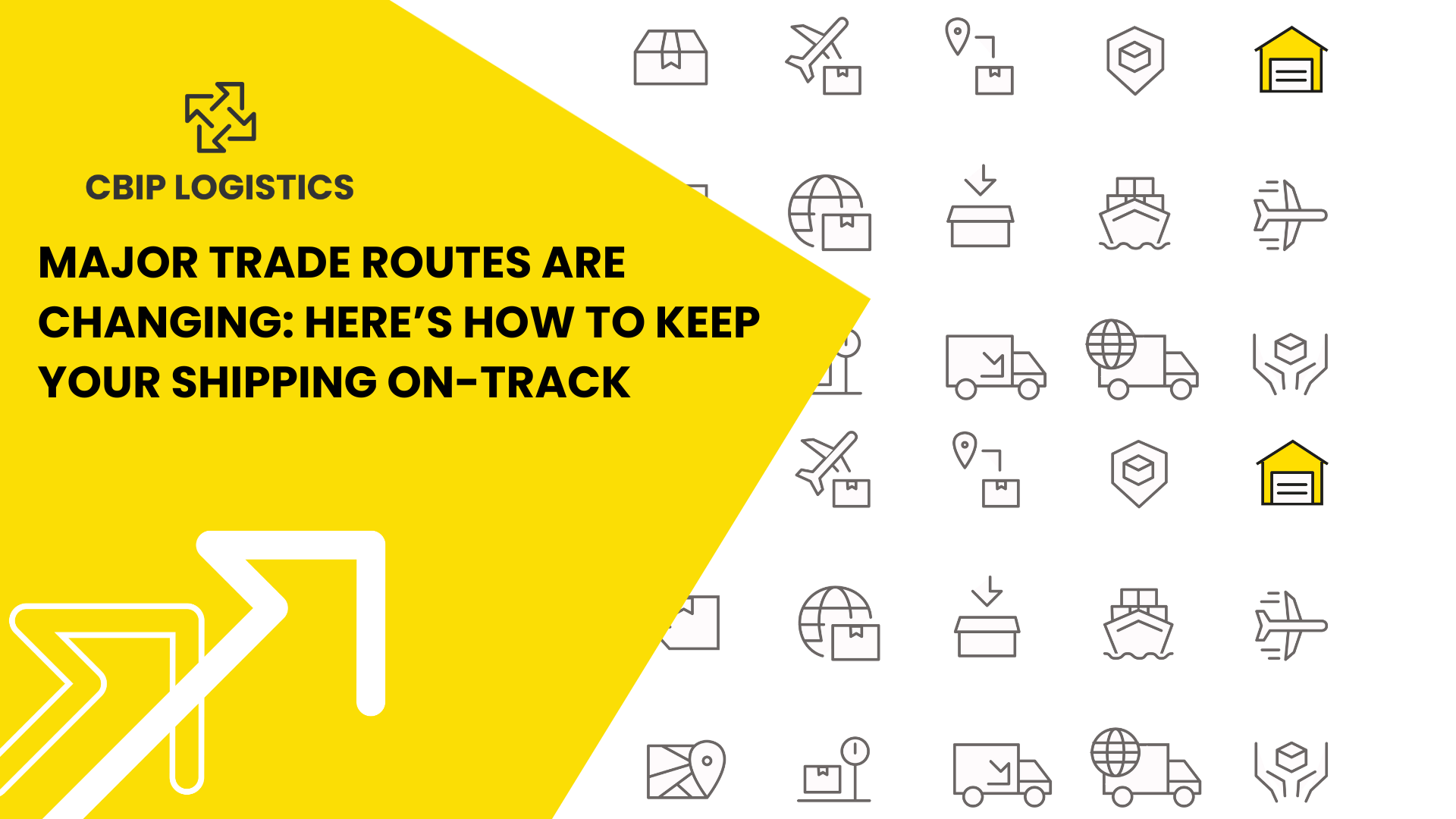Major Trade Routes Are Changing: Here's How to Keep Your Shipping On-Track

The Silk Road. The Amber Road. The Royal Road. The Ancient Tea Horse Road. The Spice Route. The Salt Route. The Tin Route. The Trans-Saharan Trade Route.
Such trade networks have shaped world history as we know it. However, times have changed. New routes replace the old as geopolitics, environmental factors, and technology evolve.
We are now living in a time when many trade routes are being reshaped dramatically, whether due to conflicts, climate disasters, or global politics. In 2025, you cannot assume that you will be safe using the same shipping routes as always.
No, this year, we have to take a close look at how trade routes are reforming and make strategic choices to update our logistics models.
Let’s talk about how the major trade routes are changing, as well as the methods that leading brands are using to make sure they optimize their shipping operation as things change.
Read About CBIP's Adaptable 4PL Logistics Services
Shipping routes you need to know
Each year, more than 50,000 merchant ships transport over 11 billion tons of goods around the world. That’s more than 2,000 pounds per person, year after year.
It can be difficult to wrap your mind around a large number like that. To get a better sense of things, here’s an interactive map from the UCL Energy Institute to help visualize what this process looks like in real-time.
With that transport volume, there’s also serious money on the line. According to the International Chamber of Shipping, 14 trillion dollars worth of goods transported by sea accounts for nearly 90% of all world trade. Ocean shipping routes are the lifeline to global commerce.
So how — and, more importantly, where — do these goods keep flowing? Here are the world’s busiest major shipping routes you need to know:
Strait of Malacca
First, there’s the Strait of Malacca. Its name is derived from the trading port that sits at the mouth of the Melaka River on the western peninsula of Malaysia. The reason it is first on this list is that it accounts for 40% of all world trade and is the shortest route between India and China.
The 500-mile strait connects the Indian Ocean and the South China Sea. It’s a key link between major Asian economies such as Japan, the Philippines, Singapore, South Korea, Taiwan, Thailand, and Vietnam.
Panama Canal
Number two on the list is the Panama Canal. Completed in 1914, this narrow 40-mile canal goes through the Isthmus of Panama. It connects the Atlantic and Pacific oceans, allowing for an average transit time of about 10 hours from end to end.
Unfortunately, Panama has experienced various droughts over the years, which have greatly impacted canal operations, with the most recent occurring in 2023 into 2024. The canal authorities were forced to limit the number of ships allowed to cross daily due to low water levels.
With around 5 percent of global trade passing through the canal, that drought had a substantial effect on worldwide shipping. Particularly for shipments heading to or from the US East Coast and Asia, the drought led to costly delays and disruptions.
Suez Canal
Since its construction in 1869, the 120-mile Suez Canal has become one of the world’s major shipping routes.
The canal cuts through the Isthmus of Suez, connecting the Mediterranean Sea and the Red Sea and serving as an effective trade route between Asia and Europe.
Unfortunately, 2024 was a particularly difficult year for the waterway. Due to the threat of Houthi attacks in the Red Sea, the number of ships passing through the canal has tanked.
The daily number of ships going through the canal in mid-October 2024 was more than 50 percent less than the peaks from the prior year. Unlike the Panama Canal situation, it isn’t just a waiting game; it’s a matter of safety.
For lack of a safer alternative, shippers have no choice but to avoid the canal and sail all the way south, around the very Southernmost tip of Africa: the Cape of Good Hope.
This new route is incredibly long and expensive compared to passage through the Suez. For instance, a ship traveling from Ras Tunara to Rotterdam around the Cape of Good Hope is 11,169 nautical miles. Using the Suez Canal, that same trip is 42% shorter at 6,436 miles.
RELATED: Worried About Grand Theft Cargo? Here’s How Your Brand Can Minimize Cargo Theft in Your Supply Chain
English Channel
Simply known as “The Channel,” this 350-mile-long shipping route links southern England and northern France. It also connects the southern portion of the North Sea at its narrowest point, the Dover Strait.
Each day, roughly 400 ships carrying over 300 tonnes travel from east to west, and over 100 ferries travel from north to south. That makes the English Channel one of the busiest marine areas in the world. It's estimated that via the Dover Strait, imports and exports reach a yearly trade valuation of 123 billion USD.
St. Lawrence Seaway
Completed in 1959, the 2,340-mile deep draft waterway connects the Atlantic Ocean to the Great Lakes, stretching all the way to Lake Superior.
From 1959 to the present day, the St. Lawrence Seaway has transported over two billion tons of cargo worth an estimated 300 billion USD. This has had a considerable impact on both the US and Canada by helping increase the trade of major commodities between the two countries.
Beyond the major shipping routes mentioned, there are other more minor trade routes that still play an important role in contributing to world trade. These include:
How to plan around the shipping route chaos?
Port strikes, climate disasters, wars, and trade wars… the list of factors ready to disrupt trade routes has gotten longer than ever.
In order to avoid costly shipping mistakes, you need to remain agile and informed about any potential issues with the trade routes, ports, and facilities you are using. That means working with the right mix and type of logistics partners and using route-optimization technology.
Use real-time data to optimize your route
Route-optimization tech uses data on things like weather forecasts and port traffic history, putting that data through AI algorithms to predict your ideal route.
The data used in route optimization systems allows shippers to more accurately predict the shortest possible route, in turn lowering overall costs and efficiently transporting goods to the individuals and communities that need them.
Some of the better systems can even pull live traffic data to reroute when piracy or port delays are reported on the current route.
Additionally, access to real-time data lays the groundwork for ongoing communication between companies and transportation services. In the event of miscommunication or something going wrong due to unforeseen circumstances, all parties can analyze real-time insights and work together with less lag.
Choose agile shipping partners
In 2025, it’s no longer wise to work with only one port or shipping partner. Expanding your logistics network to include different shippers and routes isn’t only helpful when a port strike or other disaster occurs.
In many cases, shipping inventory in advance and switching to a less popular, slower shipping route during peak shipping seasons can help you save money as well.
Working with a partner like a 4PL who has connections to various smaller shipping companies can save you money and save you from getting stuck at bottlenecks when disaster happens.
Much like diversifying shipping routes to avoid bottlenecks, expanding your logistics options in consumer services can ensure customers receive timely deliveries, even when challenges arise.
Gidon Sadovskiy, founder of Overnight Glasses, a fast glasses delivery service provider, emphasizes the importance of offering timely solutions for customers. His service ensures that customers receive their eyewear when needed, regardless of circumstances. This flexibility in delivery options mirrors the shipping industry’s broader shift toward efficiency, helping both businesses and consumers thrive in an increasingly fast-paced world.
Optimize Your Company’s Trade Routes With CBIP
Global demand for efficient transportation via the world’s major shipping routes isn’t going anywhere, and each year, consumer expectations are higher. It takes a careful strategy, built with contingency plans and driven by data, to keep customers happy.
At CBIP, we’re committed to working with you to craft logistics plans that meet the unique needs of your business. We understand the importance of utilizing data, and we’re always keeping up with the latest innovations across the industry. With a team of experts keeping up with the latest technology and a network of forward-thinking partners, we’re ready to evolve with you.
Get in touch today to learn how CBIP can help you design an agile and optimized shipping operation.






